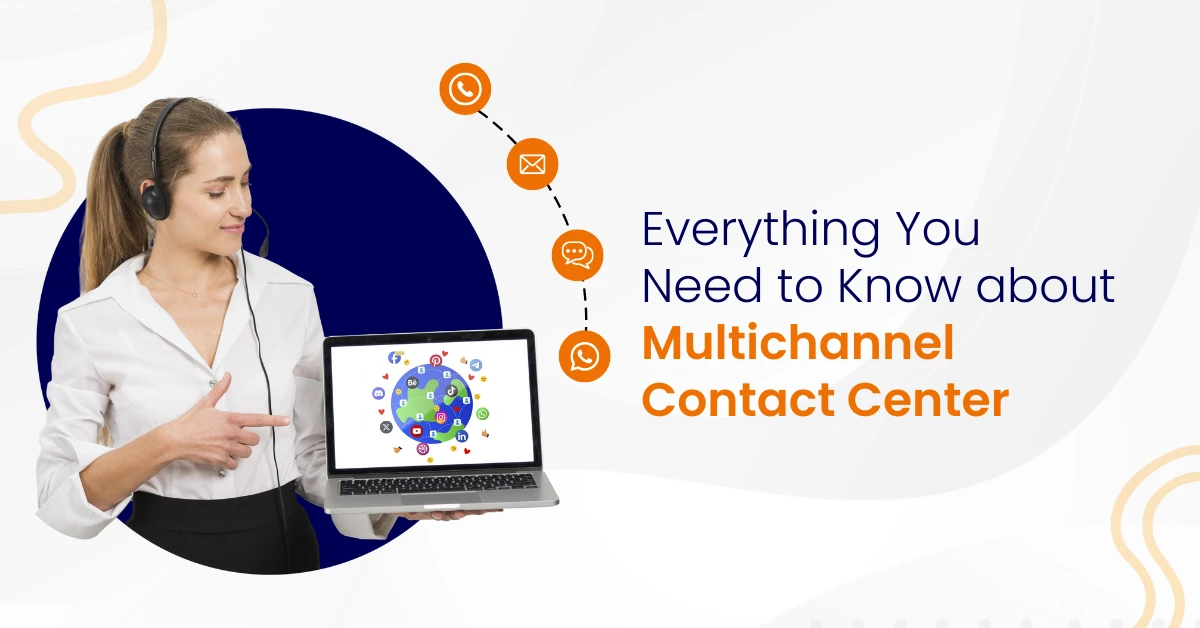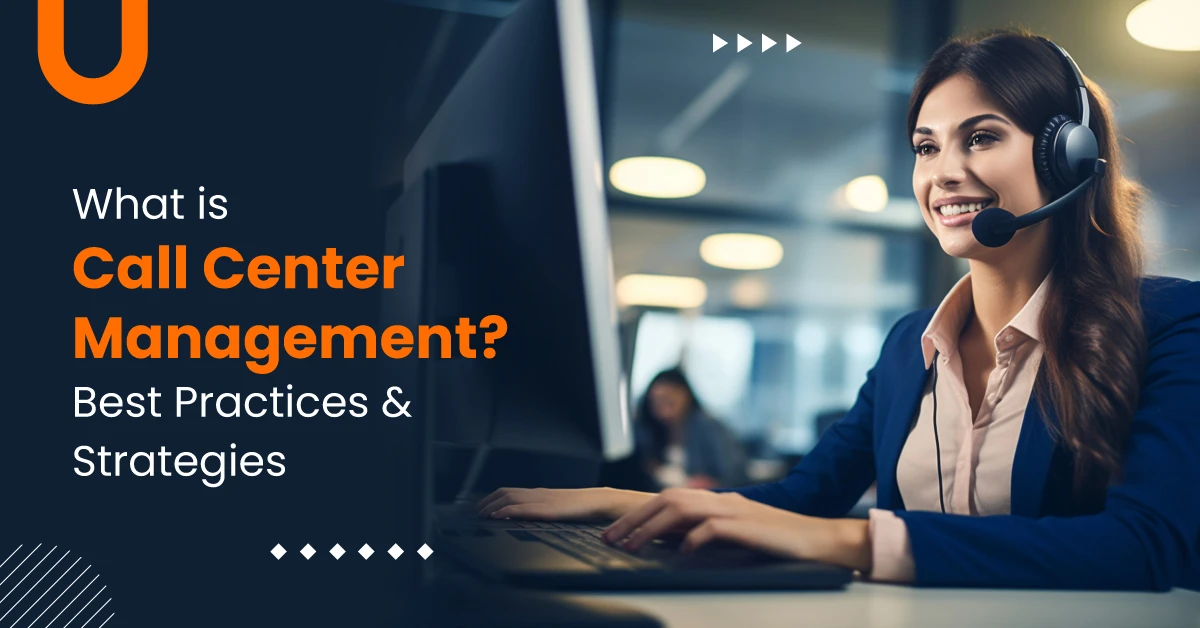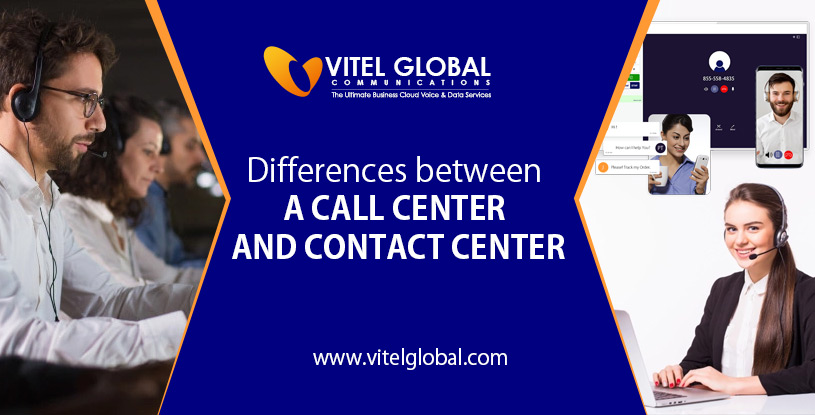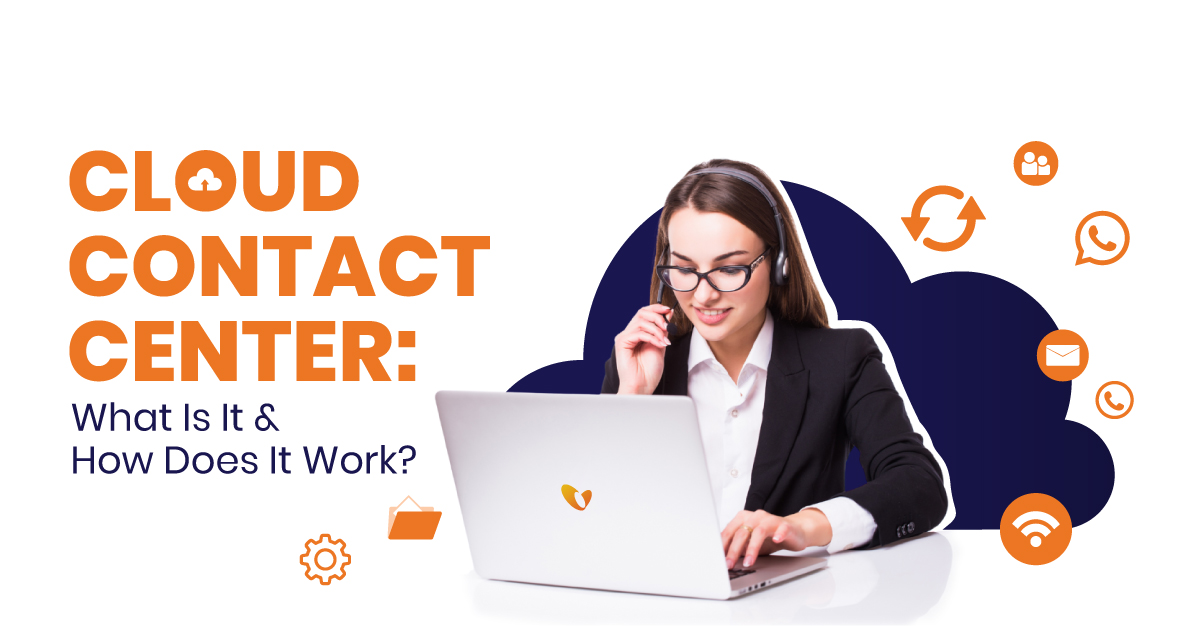Everything You Need to Know about Multichannel Contact Center

9 min read
Table of Contents
Are you tired of struggling to provide seamless customer service across different channels? A multichannel contact center is designed exactly for that solution. These days, customers reach out through multiple communication channels like phone, email, web chat, and social media, which creates multiple touchpoints across the customer’s journey.
In this blog post, we will discuss contact center solutions, including
- What is Multichannel Contact Center?
- How do they work?
- Why your business may need one?
A multichannel contact center’s work becomes far more effective when you understand customer preferences and support them on their preferred channels.
On the other hand, omnichannel contact centers bring all communication channels into one connected platform. This delivers a smooth and integrated experience for the consumers..
What is a Multichannel Contact Center?
A multichannel contact center is a customer service setup where people can reach agents across multiple channels: voice, email, web chat, and social media messaging.
These multichannel contact center channels give customers flexible communication options. This allows them to interact in their preferred channels. In many teams, contact center agents specialize in specific communication channels. This helps in resolving customer inquiries quickly and consistently.
One major benefit is improved customer satisfaction and loyalty. A multichannel call center and a multi-channel contact center expand beyond traditional call centers by managing phone interactions alongside digital channels, not only phone calls.
Customers get help faster and more conveniently, without waiting on hold as often or repeating themselves to several different service reps. In turn, businesses resolve issues faster and more efficiently because they have visibility into the various channels their customers actually use.
Another benefit of a multichannel contact center is having control over expenses. These centers help reduce frustration among customers by offering alternate communication options such as chat, email, or social media messaging.
One team can cover multiple channels, so you are not staffing separate groups for each contact option.
You can also apply automation and intelligent virtual agents to routine tasks like routing incoming calls or prioritizing issues, which trims operating costs. Be aware that different channels often require their own processes and tools, which adds complexity and calls for thoughtful planning.
Overall, there are meaningful gains for both businesses and customers. By giving customers multiple ways to reach agents and giving businesses visibility across channels, you cover more ground. It can lift the overall customer experience while controlling costs.
Looking to upgrade your phone system to support multiple channels? Contact Vitel Global’s sales team today to explore our VoIP services tailored for multichannel contact centers.
The Benefits of a Multichannel Contact Center
Offers several benefits over the traditional contact center, including
1. Increased Flexibility:
Multichannel Contact Center is more flexible than the traditional contact center. It allows agents to handle customer inquiries through various channels ( voice, chat, email, etc. ). This flexibility lets agents respond through the customer’s preferred method. This results in improved customer experience and also speeds up interactions resolved.
2. Improved Customer Service:
It also offers improved customer service. When customer interactions come in through multiple channels, agents can resolve issues more quickly and efficiently. The multichannel contact center gives people a more convenient way to receive support. With coordinated communication channels, customers get a consistent customer experience across all touchpoints.
3. Enhanced Productivity:
It can also enhance agent productivity. By handling customer inquiries through multiple channels, agents can switch context efficiently and keep work moving, which raises throughput. Multichannel contact centers streamline operations with clearer workflows and fewer redundant steps.
4. Reduced Costs:
Multichannel Contact Center can also help businesses reduce their operational costs. You avoid staffing and scripting duplicates for each channel by supporting customer inquiries across multiple channels with a single team. Simplifying operations and using automation can be a real competitive advantage for businesses.
Multichannel contact centers handle both inbound and outbound interactions across various channels, which helps shape a more seamless customer experience.
Discover how Vitel Global’s cloud communication platform can help you achieve these benefits. Request a free demo and start boosting your customer satisfaction today.
The Different Types of Multichannel Contact Centers
Multichannel contact centers are rising in popularity as companies work to deliver the best possible experience. There are several types, each with strengths and trade-offs.
Traditional call centers have served high volumes of customer calls for decades. Agents in these call centers focus on phone support and are trained to handle customer calls quickly and professionally.
The web-based call center uses an online interface to route requests and track customer interactions. It typically allows agents to access comprehensive customer data more easily, which can lift service levels over traditional call centers. These centers often integrate digital channels such as live chat and social media messaging, unifying customer interactions and improving service. Modern web-based contact center platforms also tie into customer relationship management tools and offer custom reporting to improve insight into customer calls.
Email-based call centers manage customer interactions primarily through email. This approach fits businesses that do not receive a high volume of calls but still need reliable support. Alongside email, teams can layer SMS and video call for broader coverage across different channels.
Email-based models usually have lower operating costs because they require less specialized equipment and simpler training for agents.
You can also group multichannel contact centers by the channels they support. The most common category is the voice channel, which covers phone calls and Voice over Internet Protocol calls.
Video calls and video meetings are becoming more important to multichannel strategies. Blending video with phone, email, and messaging lets agents offer visual support, share screens to troubleshoot, and tailor help on each individual contact channel. Done well, this approach improves customer satisfaction across digital channels.
Upgrade your existing phone system with Vitel Global’s VoIP services to seamlessly support voice, video, and digital channels in one platform. Contact sales today for a personalized consultation.
Communication Channels in Multichannel Contact Centers
Multichannel contact centers offer a mix of communication channels so that customers can reach through their preferred channel. Customer support feels convenient and consistent from the first touch to final resolution by connecting these communication channels into a single contact center platform.
Multichannel contact center software lets contact center agents manage multiple channels side by side. This makes customer interactions and response times better.
The most common communication channels in multichannel contact centers are:
Phone/Voice: It is the backbone of customer support. Phone support using Voice over Internet Protocol/business phone systems allows real-time conversations. It is still critical for complex customer inquiries.
Email: Email is the most reliable communication channel that lets customers communicate. Automated email responses help call centers handle high volumes efficiently.
Web Chat: Instant messaging/web chat offers instant support and quick answers. Many contact centers use chatbots for immediate help. If not solved, it passes issues to human agents.
Social Media: Teams can respond to social media messaging platforms like Facebook, Twitter, or Instagram and engage customers instantly.
SMS: Text messaging is the best channel to keep customers informed for updates, alerts, and short replies without delay.
Businesses can lift customer satisfaction and deliver a consistent customer experience by offering multiple channels and integrating them through advanced contact center software.
Customer Experience in a Multichannel Environment
Customers want a smooth experience with the ability to switch channels ( like moving from web chat to phone ) without losing context or repeating details. Multichannel contact centers address this by providing contact center agents access to comprehensive customer data and full interaction history.
This helps the agents in offering personalized and efficient support. If systems are not integrated, data can become centralized in a multichannel contact center. This leads to frustration and shows why stronger technology is needed to bridge the gaps.
Key features that enhance customer experience in multichannel contact centers include:
1. Omnichannel capabilities:
Omnichannel is the integration of multiple channels that helps unify customer interactions. It creates a consistent and smooth experience on any channel used.
2. Real-time analytics:
Access to real-time analytics allows agents to observe performance, identify trends in customer behavior, and make data-driven decisions that increase service quality.
3. Self-service options:
Self-service options help customers to resolve routine customer inquiries independently using Interactive voice response systems and online knowledge bases. This reduces wait times and frees agents for complex issues.
4. Intelligent virtual agents:
AI-driven assistants handle repetitive tasks and provide instant support, which improves efficiency and allows human agents to focus on higher-value interactions.
Security and Compliance Considerations
Multichannel contact centers manage sensitive customer data across multiple channels. Security and compliance are very necessary for this. Protecting customer information and meeting regulatory standards builds trust and protects the business from risk.
Management and integration of the communication platforms increase costs. Thus, a proper balance should be there between security investments with operational efficiency. Some of the major security and compliance considerations for multichannel contact centers are:
1. Data privacy:
Secure storage and secure transmission across all communication channels are essential. Strong data privacy policies help prevent unauthorized access and data breaches.
2. Compliance:
Following regulations such as GDPR and PCI DSS ensures customer data is handled legally and responsibly, which reduces the chance of penalties.
3. Authentication:
Verifying identities before sharing sensitive information helps prevent fraud and unauthorized access, especially when teams manage multiple channels.
4. Encryption:
Using encryption technologies like SSL and TLS protects customer data during transmission and helps keep information confidential.
Multichannel contact centers can maintain customer trust by prioritizing these security and compliance measures. It allows them to operate according to the regulatory requirements.
Metrics and Analytics for Multichannel Contact Centers
It is essential to track and analyze key performance indicators to ensure the success of a multichannel contact center. They reflect operational efficiency and customer satisfaction. Leaders can identify trends, resolve friction points, and guide training agents with clearer goals by monitoring performance with real-time analytics and custom reporting.
Important metrics and analytics for multichannel contact centers include:
1. Customer Satisfaction (CSAT)
Measures how satisfied customers feel after customer interactions across various communication channels and provides direction for service quality improvements.
2. First Contact Resolution (FCR)
Tracks the percentage of customer inquiries solved during the initial touch, which indicates how well contact center agents and processes resolve issues.
3. Average Handling Time (AHT)
Captures the average time agents spend on phone interactions, web chat, or other channels and helps identify opportunities for improved efficiency.
4. Abandon Rate
Monitors the percentage of customer calls or digital sessions that end before resolution, which often highlights challenges with call queues or average speed of answer.
5. Net Promoter Score (NPS)
Gauges loyalty and the likelihood that customers will recommend the brand, offering a broader view of customer experience.
By regularly monitoring these key performance indicators, contact centers can make informed decisions, enhance agent performance, and deliver a consistent customer experience across multiple touchpoints and preferred channels.
Harness the power of real-time analytics with Vitel Global’s contact center platform. Contact sales to discover how our tools can optimize your operations.
How to Implement a Multichannel Contact Center
A multichannel contact center requires a strategic plan that meets the customer needs and business goals. With the right software solution, businesses can simplify operations and manage multiple channels in one place. It offers the contact center agents the tools they need to provide customers with a smooth experience.
Assess Customer Needs: Learn customer preferences, the preferred method of contact, and which communication options they actually use across various channels.
Choose the Right Software: Select multichannel contact center software that integrates multiple communication channels, supports real-time analytics, and unifies interaction history.
Train Agents: Provide training agents with practical playbooks for phone support, web chat, social media messaging, and email so interactions are resolved with consistent service quality.
Establish Standard Operating Procedures: Define clear steps for routing customer calls, managing call queues, documenting customer inquiries, and escalating to the most appropriate agent.
Monitor Performance: Track key performance indicators and use custom reporting to refine contact center operations and improve efficiency for both inbound and outbound interactions.
By following these steps, businesses can implement a multichannel contact center that meets customer expectations, improves efficiency, and maintains a consistent customer experience across different channels.
Conclusion
The multichannel contact center is a reliable way to increase customer satisfaction and raise service quality. By letting people engage through multiple channels, you ensure questions and concerns are handled quickly and efficiently across digital channels and phone support. As leaders monitor performance and refine processes, improved efficiency follows for both contact center agents and customers.
In many teams, however, data from different channels lives in silos, which can hide the full interaction history. That limitation risks losing context and can affect a consistent customer experience. Closing those gaps with the right contact center platform helps manage multiple channels without friction and keeps the customer’s journey clear from start to finish.
Multichannel contact centers operate with independent channels, so journeys can feel fragmented if systems are not connected. Even so, better routing, clearer procedures, and unified reporting strengthen service across various communication channels.
Discover how Vitel Global’s multichannel contact center solutions can unify your customer communications
Frequently Asked Questions
1. What is a multichannel contact center?
A multichannel contact center lets businesses interact with customers through multiple communication channels such as phone calls, email, web chat, social media messaging, and SMS. It enables customers to use their preferred method while agents manage multiple channels efficiently.
2. How does a multichannel contact center differ from a traditional call center?
Traditional call centers focus mainly on phone interactions. A multichannel contact center supports various channels beyond phone support, which creates flexibility and helps deliver a more consistent customer experience.
3. What are the benefits of using a multichannel contact center?
Benefits include increased flexibility, improved customer satisfaction, enhanced agent productivity, reduced operating costs, and a seamless experience across multiple touchpoints and preferred channels.
4. Can customers switch between channels without losing context?
In a multichannel setup, channels may run separately, so customers might repeat details when they switch channels. Omnichannel contact centers unify channels to maintain context and interaction history.
What are some common communication channels used in
5. multichannel contact centers?
Common channels include internet protocol phone support, email, web chat, social media messaging, SMS, and, increasingly, video calls and video meetings for visual assistance.
6. How can businesses implement a multichannel contact center effectively?
Assess customer needs, select the right multichannel contact center software, train agents, create standard operating procedures, and monitor performance with real-time analytics and custom reporting.
7. What role does automation play in multichannel contact centers?
Automation and intelligent virtual agents handle routine customer inquiries, route contacts to the most appropriate agent, and streamline operations so human agents can focus on complex issues.
8. How do multichannel contact centers ensure data security and compliance?
They use encryption, authentication, and data privacy policies, and follow regulations such as GDPR and PCI DSS to protect comprehensive customer data across multiple channels.
9. What metrics should be tracked to measure multichannel contact center performance?
Track customer satisfaction, first contact resolution, average handling time, abandonment rate, and net promoter score to monitor performance and guide training agents.
10. Are multichannel contact centers suitable for all businesses?
Suitability depends on customer preferences, resources, and service goals. Some organizations may start with fewer contact options and then expand to other channels as needs grow.
Published: April 4th, 2023
Tags:
- AI Virtual Agents
- Automation in Contact Centers
- Call Center Solutions
- Chat
- Cloud Communication Platform
- contact center
- Contact Center Software
- Customer Experience
- Customer Service Metrics
- Customer Support Channels
- Email Support
- Multichannel Contact Center
- Omnichannel Customer Support
- Voicemail
- VoIP Services
- Web Chat Support
Subscribe to Our Latest Updates
Get monthly product and feature updates, the latest industry news, and more!








